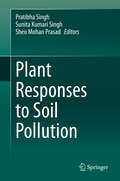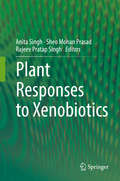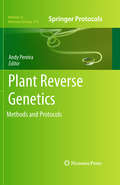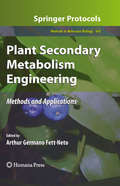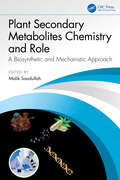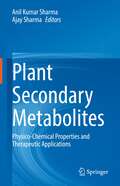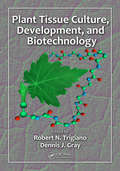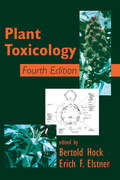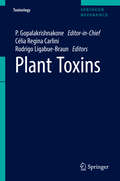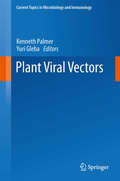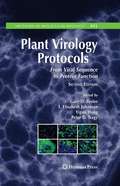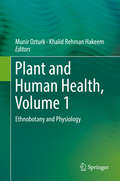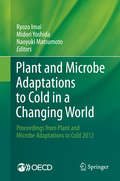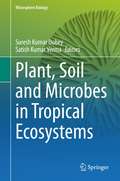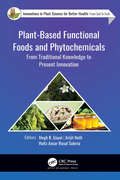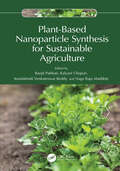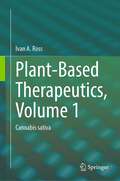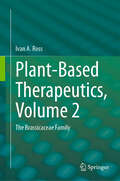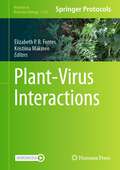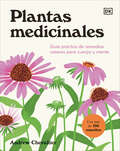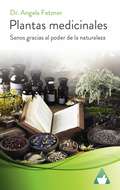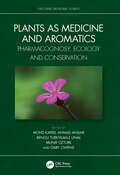- Table View
- List View
Plant Responses to Soil Pollution
by Sheo Mohan Prasad Pratibha Singh Sunita Kumari SinghSoil is a vital support system for all life forms, and is directly or indirectly exposed to various pollutants and harmful chemicals. Any pollutant entering the soil system not only affects the quality of the soil, but also the plants and crops growing in it. Further, soil pollution has far-reaching impacts, since harmful chemicals can become biomagnified and enter the food chain, causing severe health concerns. Degraded soils can adversely affect various plant systems by creating biotic and abiotic stress, which increases the chances of biochemical and physiological disorders. Chronic diseases and lower yield have been reported as consequences of soil pollution. Drawing on decades of soil-related research, this book focuses on soil pollution, types of soil pollutants, and their impacts on plant physiological and biochemical systems, along with crop productivity. The book begins with a brief introduction to soil pollution and continues with a discussion of the different types and their effects, together with remediation methods. It highlights various sources of soil pollution such as herbicides, acidification, chemical fertilizers, sewage sludge, heavy metals, and radioactive pollutants. It also covers plant responses to combinations of pollutants, effects of pollutants on plant ultrastructure, interactions between pollutants and plant diseases, and interactions between pollutants and agricultural practices. In closing, it addresses the challenges involved in the restoration of degraded land, side effects of agricultural practices in the form of greenhouse gases, and strategies for mitigating these effects. Plant Responses to Soil Pollution offers an essential guide for students, environmental consultants, researchers and other professionals involved in soil and plant-related research.
Plant Responses to Xenobiotics
by Anita Singh Sheo Mohan Prasad Rajeev Pratap SinghThis book is compilation of studies related with the xenobiotics i. e. chemical or other substance that is not normally found in the ecosystems and get accumulated at higher concentration in the biological system due to rampant industrialisation and urbanisation activities. This book has tried to give information on various issues to give comprehensive and concise knowledge of the recent advancement in the field of environmental xenobiotics and how it disturbs the plants metabolism. Other key features of the book are related to xenobiotic toxicity and detoxification mechanism, biochemical tools toward its remediation processes, molecular mechanism for xenobiotics detoxification and effect on metallomics. It also focuses on recent development in the field of waste water remediation concerned with the xenobiotics involvement. This book is different in such a way that it includes all the initial information along with the new researches. It includes the description of problem along with its solution. This volume describe the effects of xenobiotics at different levels i. e. biochemical, physiological and molecular, giving the details on signaling pathways to modify the responses of xenobiotics in plant system. Thus, it gives confirming crosstalk between xenobiotic effects and signalling pathways. This book includes description about both the organic contaminants such as pesticides, solvents and petroleum products as well as inorganic xenobiotics that include heavy metals, non-metals, metalloids, and simple soluble salts. Here the plant is main objective and that have to deal with these kinds of compounds either by avoiding accumulation of these compounds or by exhibiting several enzymatic reactions for detoxification including oxidation, reduction, and conjugation reactions. Affected plants exhibit several enzymatic and non-enzymatic antioxidant and other reactions for detoxification of ROS including oxidation, reduction, hydrolysis and conjugation reactions. The book focuses on different forms and sources of xenobiotics including organic and inorganic xenobiotics. The matter of this book will definitely increase the knowledge about the impacts of xenobiotics on plants system. There must be potentially broad readership who could find this fruitful for their study as well as for their research. As this book has balance between basic plant physiology and toxicity caused by the xenobiotics so it can be widely used in several disciplines. Overall, the book will bring deep knowledge in the field of xenobiotics toxicity in plants during recent years and it is definitely a compilation of interesting information which isn't fully covered elsewhere in the current market.
Plant Reverse Genetics
by Andy PereiraAfter the generation of genome sequence data from a wide variety of plants, databases are filled with sequence information of genes with no known biological function, and while bioinformatics tools can help analyze genome sequences and predict gene structures, experimental approaches to discover gene functions need to be widely implemented. In Plant Reverse Genetics: Methods and Protocols, leading researchers in the field describe cutting-edge methods, both high-throughput and genome-wide, involving the models Arabidopsis and rice as well as several other plants to provide comparative functional genomics information. With chapters on the analysis of high-throughput genome sequence data, the identification of non-coding RNA from sequence information, the comprehensive analysis of gene expression by microarrays, and metabolomic analysis, the thorough methods of the book are fully supported by scripts to aid their computational use. Written in the highly successful Methods in Molecular BiologyTM series format, the chapters contain introductions to their respective topics, lists of the necessary materials, step-by-step, readily reproducible laboratory protocols, and notes on troubleshooting and avoiding known pitfalls. Authoritative and essential, Plant Reverse Genetics: Methods and Protocols is an ideal guide for researchers seeking an understanding of how the complex web of plant genes work together in a systems biology view.
Plant Secondary Metabolism Engineering
by Arthur Germano Fett-NetoPlants have evolved an amazing array of metabolic pathways leading to molecules capable of responding promptly and effectively to stress situations imposed by biotic and abiotic factors, some of which supply the ever-growing needs of humankind for natural chemicals, such as pharmaceuticals, nutraceuticals, agrochemicals, food and chemical additives, biofuels, and biomass. In Plant Secondary Metabolism Engineering: Methods and Applications, expert researchers provide detailed practical information on some of the most important methods employed in the engineering of plant secondary metabolism pathways and in the acquisition of essential knowledge in performing this activity, including the significant advances and emerging strategies. Written in the highly successful Methods in Molecular BiologyTM series format, chapters include introductions to their respective topics, lists of the necessary materials and reagents, step-by-step, readily reproducible laboratory protocols, and notes on troubleshooting and avoiding known pitfalls. Authoritative and cutting-edge, Plant Secondary Metabolism Engineering: Methods and Applications will aid scientists engaged in the challenging task of modifying some of the most intricate products of plant evolution and support their efforts directed toward the vital goal of sustainable natural chemicals.
Plant Secondary Metabolites Chemistry and Role: A Biosynthetic and Mechanistic Approach
by Malik SaadullahFor centuries the vast and versatile pharmacological effects of medicinal plants and their constituents have played vital roles in biological, economic, social, spiritual, cultural and physiological well-being. This unique text establishes a groundwork in natural product chemistry and phytochemistry by considering the biosynthesis and mechanistic way. There is abundant evidence showing that medicinal plants and their secondary metabolites are useful in preventing different ailments and this book discusses this as well as the mechanisms, amelioration, and biosynthesis of these metabolites. It helps readers to understand the computational, toxicological, cosmetic and nutraceutical aspects of plant secondary metabolites.
Plant Secondary Metabolites: Physico-Chemical Properties and Therapeutic Applications
by Ajay Sharma Anil Kumar SharmaPlant secondary metabolites are plant-based natural products that display a variety of pharmacological effects. This book discusses the invaluable bioactivity and multifaceted potential of these compounds. The book describes the physico-chemical and biochemical aspects of the plant secondary metabolites along with the chemistry, therapeutics and future perspectives of these plant secondary metabolites. Moreover, the book also discusses about various sources of plant secondary metabolites, and the metabolite determination through various analytical techniques. It further describes the potential applications of plant secondary metabolites as anticancer and chemo preventive agents, their role as cosmetic ingredients and activity in skin cancer therapy. Further chapters emphasize upon the plethora of roles of plant secondary metabolites, including those as antivirals, anti-bacterial, anti-inflammatory drugs, cardioprotective agents etc. The book culminates with chapters on the impact of certain plant secondary metabolites in plant defence and human healthcare. This book is meant for researchers and students in the field of pharmacology and plant sciences. Moreover, this book is also useful for industry experts especially working in the field of herbal therapeutics.
Plant Tissue Culture, Development, and Biotechnology
by Robert N. Trigiano Dennis J. GrayUnder the vast umbrella of Plant Sciences resides a plethora of highly specialized fields. Botanists, agronomists, horticulturists, geneticists, and physiologists each employ a different approach to the study of plants and each for a different end goal. Yet all will find themselves in the laboratory engaging in what can broadly be termed biotechnol
Plant Toxicology
by Bertold Hock Erich F. ElstnerIn order to keep track of all the compounds and pathogens affecting plant metabolism and development, you would need to spend all your waking hours combing periodicals and the Internet in dozens of languages, as new toxins via pollutants and migratory or mutant pathogens are being discovered every day. Plant Toxicology, Fourth Edition start
Plant Toxins
by Célia Regina Carlini Rodrigo Ligabue-BraunThis volume, in its over two dozen chapters, constitutes an overview of the current plant toxin research. It covers from general aspects of plant toxicity to in-depth reviews of various classes of toxins, their structures, synthesis, modes of action, and upcoming uses in biotechnology. It provides an encompassing landscape of plant toxinology for both toxinologists and non-toxinologists alike.
Plant Viral Vectors
by Kenneth Palmer Yuri GlebaIn this volume, the authors provide an excellent overview of how far the plant viral vector field has come. The discipline is no longer exclusively in the domain of academics--there is a small, but growing number of small biotechnology companies that exploit plant viruses as the platform for commercial innovation in crop improvement, industrial product manufacturing, and human and veterinary health care.
Plant Virology Protocols
by Yiguo Hong Peter Nagy Elisabeth Johansen Gary FosterFollowing the considerable success of the first edition of Plant Virology Protocols, this exciting new edition covers the many new techniques that are now applied to the examination and understanding of plant viruses. Each section presents the most novel methods and step-by-step reproducible laboratory protocols to allow researchers more effective approaches to study plant viruses. This updated book will prove indispensable to laboratory investigators studying plant viruses.
Plant and Animal Proteins in Health and Disease Prevention
by Victor R. PreedyThis book explores the vital role of proteins in human health through 40 in-depth chapters, organized into four comprehensive sections which include Introductory Concepts, Foods of Animal Origin, Foods of Plant Origin, and Resources. The book delves into the biochemical processes behind protein metabolism and its influence on a wide range of health conditions. Aimed at educating readers on the diverse sources and types of protein, it provides valuable insights into how both plant and animal proteins contribute to disease prevention and overall wellness.Features Chapters feature subsections titled "Effects of other Proteins" to aid comparative interpretation Contains a mini-dictionary of terms and summary points in each chapter to facilitate clear understanding Highly illustrated with figures and multiple tables in each chapter Chapter contributors represent global coverage Plant and Animal Proteins in Health and Disease Prevention is written for nutritionists, food scientists, health care professionals, research scientists and practitioners, and policy makers. It is also practically designed for professors, students, and libraries.
Plant and Human Health, Volume 1: Ethnobotany and Physiology
by Khalid Rehman Hakeem Munir OzturkEarly anthropological evidence for plant use as medicine is 60,000 years old as reported from the Neanderthal grave in Iraq. The importance of plants as medicine is further supported by archeological evidence from Asia and the Middle East. Today, around 1.4 billion people in South Asia alone have no access to modern health care, and rely instead on traditional medicine to alleviate various symptoms. On a global basis, approximately 50 to 80 thousand plant species are used either natively or as pharmaceutical derivatives for life-threatening conditions that include diabetes, hypertension and cancers. As the demand for plant-based medicine rises, there is an unmet need to investigate the quality, safety and efficacy of these herbals by the “scientific methods”. Current research on drug discovery from medicinal plants involves a multifaceted approach combining botanical, phytochemical, analytical, and molecular techniques. For instance, high throughput robotic screens have been developed by industry; it is now possible to carry out 50,000 tests per day in the search for compounds, which act on a key enzyme or a subset of receptors. This and other bioassays thus offer hope that one may eventually identify compounds for treating a variety of diseases or conditions. However, drug development from natural products is not without its problems. Frequent challenges encountered include the procurement of raw materials, the selection and implementation of appropriate high-throughput bioassays, and the scaling-up of preparative procedures. Research scientists should therefore arm themselves with the right tools and knowledge in order to harness the vast potentials of plant-based therapeutics. The main objective of Plant and Human Health is to serve as a comprehensive guide for this endeavor. Volume 1 highlights how humans from specific areas or cultures use indigenous plants. Despite technological developments, herbal drugs still occupy a preferential place in a majority of the population in the third world and have slowly taken roots as alternative medicine in the West. The integration of modern science with traditional uses of herbal drugs is important for our understanding of this ethnobotanical relationship. Volume 2 deals with the phytochemical and molecular characterization of herbal medicine. Specifically, it focuess on the secondary metabolic compounds, which afford protection against diseases. Lastly, Volume 3 discusses the physiological mechanisms by which the active ingredients of medicinal plants serve to improve human health. Together this three-volume collection intends to bridge the gap for herbalists, traditional and modern medical practitioners, and students and researchers in botany and horticulture.
Plant and Microbe Adaptations to Cold in a Changing World
by Naoyuki Matsumoto Ryozo Imai Midori YoshidaThis book includes papers from keynote lecture and oral presentations of Plant and Microbe Adaptations to Cold (PMAC) 2012, an international conference on winter hardiness of crop and pathogenic microbes. The PMAC has been started in 1997 in Japan as an interdisciplinary forum for scientists and extension people working in the field in plant pathology, plant physiology, microbiology, and crop breeding to increase our knowledge and improve our understanding of overwintering of crops, forages and grasses and solve the problems associated with losses due to freezing and heavy snow cover. Successive meetings have been held in Iceland (2000), Canada (2003), Italy (2006), and Norway (2009). PMAC2012 will be a special meeting with a focus on global climate change, food security and agriculture sustainability and the whole program will be arranged to reflect this theme. The topics covered by this proceedings includes, global warming in agricultural environment, plant adaptations to cold, microbial adaptations to cold, plant-microbe interaction under cold, and molecular breeding for winter hardiness. The researches range from molecular biology to ecology and breeding. Experts in the field will report cutting edge research and thoughtful strategies for sustainability.
Plant, Soil and Microbes in Tropical Ecosystems (Rhizosphere Biology)
by Satish Kumar Verma Suresh Kumar DubeyThis book describes the multitude of interactions between plant, soil, and micro-organisms. It emphasizes on how growth and development in plants, starting from seed germination, is heavily influenced by the soil type. It describes the interactions established by plants with soil and inhabitant microbial community. The chapters describe how plants selectively promote certain microorganisms in the rhizospheric ecozone to derive multifarious benefits such as nutrient acquisition and protection from diseases. The diversity of these rhizospheric microbes and their interactions with plants largely depend on plant genotype, soils attributes, and several abiotic and biotic factors. Most of the studies concerned with plant–microbe interaction are focused on temperate regions, even though the tropical ecosystems are more diverse and need more attention. Therefore, it is crucial to understand how soil type and climatic conditions influence the plant–soil–microbes interaction in the tropics. Considering the significance of the subject, the present volume is designed to cover the most relevant aspects of rhizospheric microbial interactions in tropical ecosystems. Chapters include aspects related to the diversity of rhizospheric microbes, as well as modern tools and techniques to assess the rhizospheric microbiomes and their functional roles. The book also covers applications of rhizospheric microbes and evaluation of prospects improving agricultural practice and productivity through the use of microbiome technologies. This book will be extremely interesting to microbiologists, plant biologists, and ecologists.
Plant-Based Functional Foods and Phytochemicals: From Traditional Knowledge to Present Innovation (Innovations in Plant Science for Better Health)
by Megh R. Goyal Arijit Nath Hafiz Ansar Rasul SuleriaPlant-Based Functional Foods and Phytochemicals: From Traditional Knowledge to Present Innovation covers the importance of the therapeutic health benefits of phytochemicals derived from plants. It discusses the isolation of potential bioactive molecules from plant sources along with their value to human health. It focuses on physical characteristics, uniqueness, uses, distribution, traditional and nutritional importance, bioactivities, and future trends of different plant-based foods and food products. Functional foods, beyond providing basic nutrition, may offer a potentially positive effect on health and cures for various disease conditions, such as metabolic disorders (including diabetes), cancer, and chronic inflammatory reactions. The volume looks at these natural products and their bioactive compounds that are increasingly utilized in preventive and therapeutic medications and in the production of pharmaceutical supplements and as food additives to increase functionality. It also describes the concept of extraction of bioactive molecules from plant sources, both conventional and modern extraction techniques, available sources, biochemistry, structural composition, and potential biological activities.
Plant-Based Nanoparticle Synthesis for Sustainable Agriculture
by Naga Raju Maddela Kondakindi Venkateswar Reddy Ranjit Pabbati Kalyani ChepuriThe use of nanotechnology in agriculture has created many concerns related to toxicity and environmental implications. Green synthesis techniques for producing nanomaterials utilizing plants, microorganisms, and other natural resources have been developed in response to the demand for green chemistry and nanotechnology. This book provides in-depth information on the plant-based synthesis of nanoparticles and how it promotes sustainable agriculture. It critically reviews nanomaterials synthesized from plants and their potential applications, including nanoscale insecticides, herbicides, fungicides, fertilizers, and sensors, which can help to study and manage plant health and soil fertility.The features of this volume include: A comprehensive resource on plant-based nanoparticle synthesis and its usage in gene transformation; Strategies and limitations of plants that are genetically engineered using nanotechnology; Explanation of the design and use of nanofertilizers and nonopesticides for environmental sustainability; Discussions around the toxicity levels of nanoparticles in plants; Aids for professionals and scholars to learn advanced techniques to monitor soil and plant systems using nanotechnology. This is an excellent reference for researchers, academics, students, and professionals in nanotechnology, biochemistry, biomedical sciences, biotechnology, environmental engineering, agricultural sciences, and plant sciences.
Plant-Based Therapeutics, Volume 1: Cannabis sativa
by Ivan A. RossBy examining historical applications of the compounds found in plants, this five-volume series serves as a reference for quality assurance, research, product development, and regulatory guidance of the compounds found in plant-based medicines. This work supports the growing consumers' interest in herbal medicine for wellness and health. Plant-Based Therapeutics, Volume 1: Cannabis sativa, the first in the series, covers a unique plant species and provides the framework to integrate its evidence-based scientific discoveries with healthcare therapies. Cannabis has been used in religious ceremonies and medical purposes for thousands of years. Cannabidiol (CBD), the main non-psychoactive component of Cannabis, was isolated in the 1940s, and its structure was established in the 1960s. In 1964 tetrahydrocannabinol (THC), the psychoactive component, was isolated. Cannabis has more than 500 components, of which 104 cannabinoids have been identified. Two of them, THC and CBD, have been the primary components of scientific investigations. They were approved by the FDA for chemotherapy-induced nausea and vomiting in 1985; for appetite stimulation in wasting conditions, such as AIDS, in 1992, and in 2018 for treating two forms of pediatric epilepsy, Dravet syndrome and Lennox-Gastaut syndrome. Beyond the indications for which cannabinoids are FDA-approved, the evidence reveals that cannabinoid receptors are present throughout the body, embedded in cell membranes, and are believed to be more numerous than any other receptor system. When cannabinoid receptors are stimulated, a variety of physiologic processes ensue. Thus, other constituents of Cannabis are extremely promising either as individual compounds or their potential synergistic or entourage effects in the treatment of numerous medical conditions.
Plant-Based Therapeutics, Volume 2: The Brassicaceae Family
by Ivan A. RossFor centuries, research has been conducted on the therapeutics of Brassicaceae plants and their health-promoting effects. Cato the Elder (234-149 BCE) documented their properties in his work De agri cultura and recommended using cabbage to compress wounds, swelling, burns, and bone dislocations. For arthritis, he recommended chopped raw cabbage mixed with coriander and cured cabbage mixed with vinegar and honey. In a groundbreaking discovery in the 1990s, scientists at Johns Hopkins University isolated sulforaphane from broccoli, revealing its potent anticancer properties. This naturally occurring compound has proven highly effective, safe, and tolerable and holds immense promise as a chemoprevention agent. It has the potential to combat various cancers, including breast, prostate, gastrointestinal, melanoma, lung, brain, and bladder. But its potential does not stop there. It also shows promise in treating cardiovascular and neurodegenerative diseases and diabetes, offering hope for those affected. The cancer-protecting properties of Brassica plants are mediated through compounds that induce a variety of physiological processes, including antioxidant action, detoxifying enzymes, inducing apoptosis, and cell cycle regulation. Glucosinolate breakdown products can affect several stages of cancer development, including the inhibition of activation enzymes (phase I) and the induction of detoxification enzymes (phase II). Isothiocyanates and indole products formed from glucosinolates regulate cancer cell development by regulating target enzymes, controlling apoptosis, inhibiting angiogenesis, metastasis, and the migration of cancer cells, and blocking the cell cycle. Sulforaphane, found in abundance in broccoli sprouts, plays a crucial role in upregulating the transcriptional activity of specific genes and restoring epigenetic alterations. This is particularly significant as it modifies epigenetic pathways by targeting histone deacetylases and DNA methyltransferases. These modifications, in turn, alter gene transcription and expression, particularly in the case of cancers. This intricate process of gene regulation is a fascinating study area, making broccoli sprouts a compelling component of the 'epigenetic diet.' Sulforaphane induces the cytoprotective enzyme NQO1. The inducible expression of NQO1 is regulated principally through the Keap1-Nrf2-ARE signaling pathway. The activation of the Nrf2-Keap1 signaling pathway heralds the beneficial actions of drugs known to affect Nrf2 signaling, such as dimethyl fumarate, an FDA-approved treatment for multiple sclerosis, and bardoxolone methyl for chronic kidney disease. There is optimism that the overall strategies are moving forward. Sulforaphane-rich broccoli sprout extracts provide one avenue toward this end.
Plant-Microbe Interactions: Harnessing Next-Generation Molecular Technologies for Sustainable Agriculture (Advances and Applications in Biotechnology)
by Jagajjit SahuA constant research effort to understand plant-microbe interactions makes it indispensable to keep abreast of the latest research developments. Researchers from a range of disciplines have used multiple approaches to infer this field. With the advent of next-generation techniques, both molecular and computational, the field has entered a new phase. These approaches often result in massive information, which is sometimes tangled and in need of further analysis. These types of analyses also require cutting-edge data analytics as well as efficient statistical models. Plant-Microbe Interactions: Harnessing Next-Generation Molecular Technologies for Sustainable Agriculture provides a comprehensive picture of the modern-day analytics and approaches being used to provide insights into the interactions between plant and microbe. A wide range of technologies are explored along with practical guides toward these techniques. A detailed understanding of omics data in various areas could be obtained from this compilation. Key Features: • Crosstalk between plant and microbe • Overview of advanced molecular techniques used to study plant-microbe interaction • Practical guide to technologies such as NGS • Omics data analysis used to study plant-microbe interaction • Role of soil metagenomics • Advanced technologies such as nanotechnology and CRISPR serving to study plant-microbe interaction This book will serve as a great reference to various next-generation techniques in the field of plant-microbe interaction, thereby helping to better understand the mechanism. This will also help budding researchers to shape their research in similar areas.
Plant-Virus Interactions (Methods in Molecular Biology #2724)
by Elizabeth P. B. Fontes Kristiina MäkinenThis detailed volume provides practical guidance on techniques in plant-virus interaction research, from targeting specific molecular interactions within the virus-host interactome to the identification of the complete virus-host protein-protein interaction network. After chapters on acquiring the necessary molecular tools, the book continues with biochemical and genetic approaches to confirming protein-protein interactions both in vivo and in vitro, procedures and protocols for assessing replication, translation, viral genome movement, and insect transmission, as well as techniques for detecting multiple molecular interactions between the host and the virus and monitoring immune hubs. Written for the highly successful Methods in Molecular Biology series, chapters include introductions to their respective topics, lists of the necessary materials and reagents, step-by-step and readily reproducible laboratory protocols, and tips on troubleshooting and avoiding known pitfalls. Authoritative and comprehensive, Plant-Virus Interactions serves as a valuable resource for understanding the protein-protein interaction network between the virus and the host, crucial for comprehending the life cycle of a virus and for developing strategies for broad-spectrum and long-lasting resistance against viral infections.
Plantas medicinales (The Home Herbal): Guía práctica de remedios caseros para cuerpo y mente
by Andrew Chevallier¡Cuida de tu salud con más de 100 recetas de remedios naturales super fáciles de preparar!La naturaleza nos proporciona miles de remedios para mejorar nuestro bienestar físico y mental. ¿Te gustaría aprender a elaborarlos y curarte naturalmente? Este libro de autocuidado te ofrece el asesoramiento y el apoyo que necesitas para tratar tus problemas de salud con remedios caseros de forma segura y eficaz. Identifica las causas de diferentes enfermedades y dolencias y explora cómo tratar sus síntomas, desde trastornos del sueño y resfriados comunes hasta problemas menstruales y cardíacos.En el interior de este manual de remedios caseros, encontrarás: Más de 100 recetas medicinales para una mente y un cuerpo sanos.Técnicas e instrucciones paso a paso para preparar remedios en casa, perfectas tanto para principiantes como para herbolarios experimentados.Consejos sobre cómo curar heridas; aliviar dolores de cabeza y de garganta; reducir problemas de salud emocional y tratar enfermedades graves o de larga duración como la cistitis crónica o la presión arterial alta.Bonitas ilustraciones y un diseño moderno.Estructurado y pensado para ayudarte a encontrar fácilmente el remedio más adecuado en base a tus necesidades, Plantas medicinales te ofrece además toda la información para conocer mejor cómo funciona tu cuerpo y comprender así el origen de tus problemas de salud.¡Domina las técnicas necesarias para elaborar medicamentos efectivos e incluye las plantas medicinales en tu rutina de autocuidado!Boost your health and improve your self-care with over 100 herbal medicine recipes to make at homeLearn how to make over 100 easy herbal remedies at home that will improve both your mental and physical well-being. Organized by everyday needs and ailments rather than by herb, this intuitive, beautifully illustrated guide will help you find the right herbal restorative for you, investigate the root of problems, and better understand your physiology. Celebrated herbal practitioner and best-selling author Andrew Chevallier offers a holistic approach to natural medicine. He will teach you not only to treat symptoms, but to identify their causes and explore the mind-body connection, so you can meaningfully apply each simple herbal solution. Covering everything from poor sleep, common colds, and menstrual problems to low mood, heart health, and safe dosages, discover how you can make plant remedies an integral part of your self-care routine and master essential medicine-making techniques for maximum efficacy.This is the indispensable companion to self-healing with herbal remedies.
Plantas medicinales: Sanos gracias al poder de la naturaleza
by Dr Angela FetznerFitoterapia - El método terapéutico más antiguo del mundo Los remedios naturales, especialmente las plantas medicinales, han sido durante mucho tiempo el único reservorio farmacológico para médicos y farmacéuticos. Las plantas medicinales se han utilizado además como materias primas básicas en la producción de medicamentos. Identificación, Recolección y Desecación de Plantas Medicinales Plantas medicinales se ven casi por doquier, esparcidas por los suelos de los prados, bosques y a lo largo de caminos y senderos. Este libro nos sirve de guía para aprender a recolectar e identificar plantas medicinales y explica qué partes de la planta - flores, hojas, frutos, raíces y cortezas – han de utilizarse para los diferentes preparados galénicos. Preparados con hierbas medicinales – Las maneras de utilizar las plantas medicinales son muy diversas Aunque existen muchas formas de utilizar y aprovechar las propiedades de las plantas medicinales, la infusión es una de las más sencillas. Entre los preparados más habituales están, por ejemplo, las tinturas, pomadas y cremas, además de su aplicación en forma de baños terapéuticos. El presente libro ofrece una visión de conjunto sobre la preparación y aplicación de las diferentes formas farmacéuticas
Plants and Phytomolecules for Immunomodulation: Recent Trends and Advances
by Luzia V. Modolo Mohamed A. Farag Neelam S. SangwanThis book describes the process of immunomodulation and the plants which possess immunomodulation properties to boost the immune system. The immunomodulation process is highly relevant to address emerging as well as existing diseases in humans. A better immune system triggers the cellular responses for neutralizing and combating the onset of disease conditions. Chapters in the book discuss plants that have profound effects on the health and well-being of humans. They discuss the natural phytochemicals that have immense diversity and uniqueness of molecules. Molecules belonging to phenylpropanoids, terpenoids, steroids, alkaloids, and tannins etc possess a variety of pharmacological activities. The chapters describe how bioactive exert effects even when taken as part of the diet, supplement, and or as traditional herbal medicine. This book provides up-to-date scientific knowledge about the activities and mechanisms and leads in the area of medicinal plants and phytochemicals with immunomodulation properties. This book is meant for students, academics, researchers, and industry professionals interested in pharmacology, immunology, and plant secondary metabolites.
Plants as Medicine and Aromatics: Pharmacognosy, Ecology and Conservation (Exploring Medicinal Plants)
by Mohd Kafeel Ahmad Ansari, Bengu Turkyilmaz Unal, Munir Ozturk, and Gary OwensSince ancient times, plants serve as a valuable source of traditional herbal medicines. Unlike modern medicines, herbal medicines have consistently demonstrated health advantages, including a lack of serious adverse side effects, long-lasting curative impacts and overall cost-effectiveness. Even today, with various modern pharmaceutical medicines commonly available, plant-based medicines and aromatics are increasingly in demand throughout the health sector globally, where they are used not only for the treatment of disease, but also, preventatively for maintaining good health. People are seeking alternatives to modern medical treatments turning to phytomedicine for primary health care. However, an inadvertent consequence of this increased demand for herbal medicines has resulted in medicinal plants being threatened due to their initial small population sizes, narrow distribution areas, habitat specificity, and increasingly destructive non-sustainable harvesting. This book critically examines and reviews the status of medicinal plants and includes several important case studies of representative plant species. It contains information on aspects concerning phytochemistry, natural products, cultivation, conservation techniques, environmental interactions, and therapeutic features of medicinal aromatic plants. Features Evaluates plants as medicine and aromatics covering pharmacognosy and ecology of plants having therapeutic values. Discusses how plants can play a role in treatment of diseases and as potential therapeutics standards for maintaining good health. Presents conventional and contemporary approaches to conservation of such plants with commercial feasibility.
